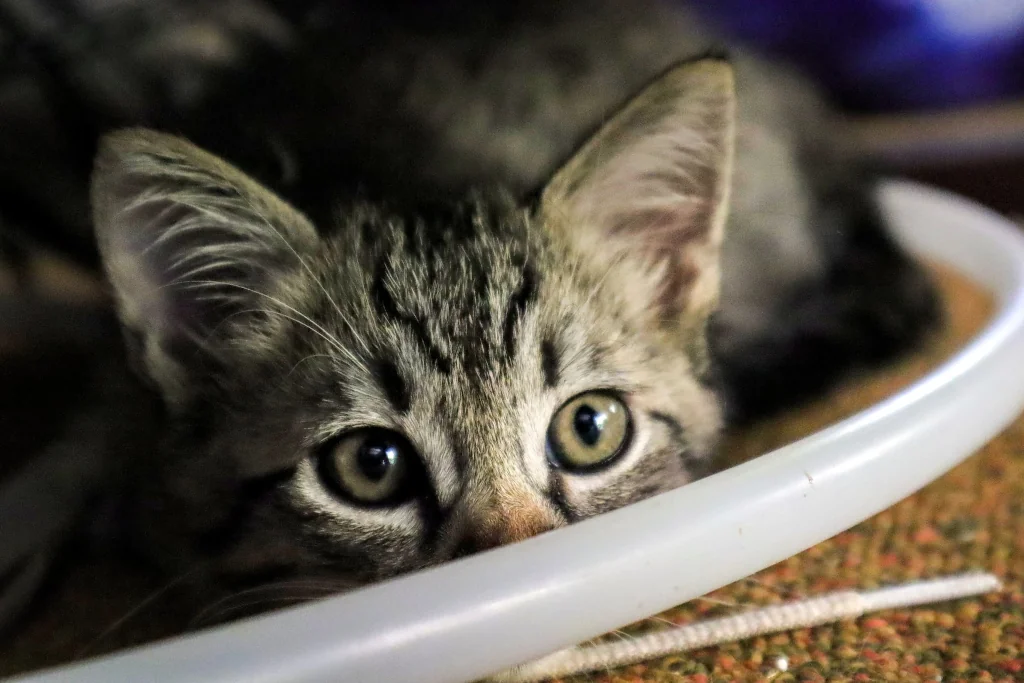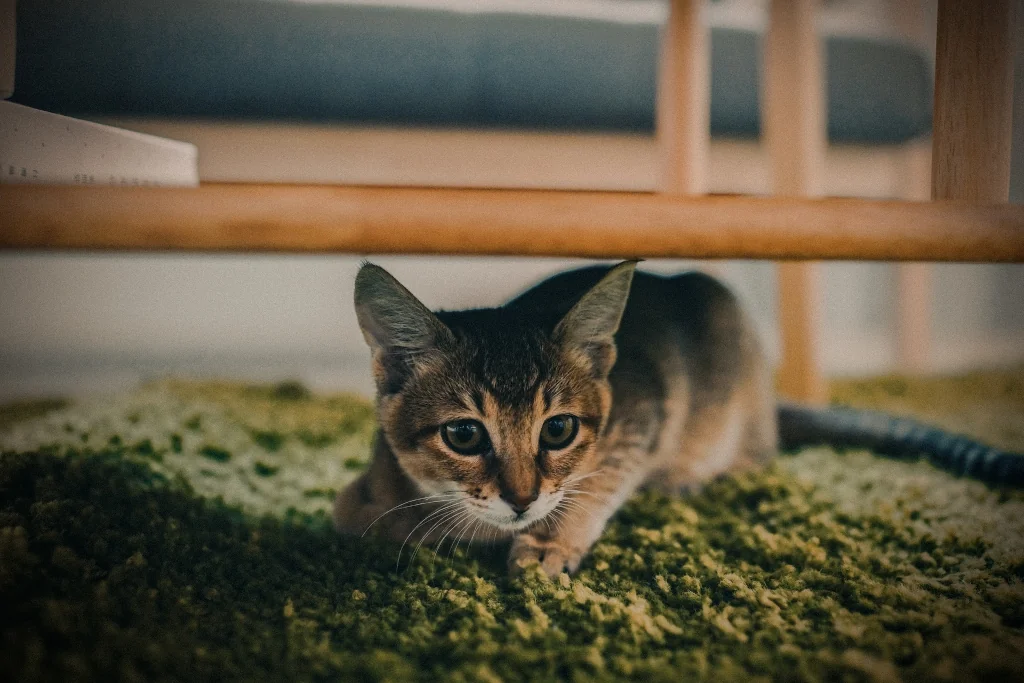Disclosure: We may earn a commission from helpful, relevant links in our content. No cost to you. See our privacy policy.
A timid cat can seem like a furry enigma.
Their jittery retreats and sudden skittishness can sometimes leave you grappling for answers. When your playful buddy trades in pouncing for hiding, it tugs at your heartstrings.
You want nothing more than to see your cat’s tail held high, exploring the house with eyes wide open, filled with curiosity and confidence.
Stay with us as we guide you on a journey to transform your shy feline into a confident cat, one paw at a time.

The Tell-Tale Signs of a Shy or Fearful Cat
Recognizing the signs of a timid or frightened cat is the first step in your mission to boost your feline’s confidence.
These signs could range from a reduced appetite to unusual aggression. Shy or fearful cats may also excessively groom themselves, to the point of hair loss in certain areas.
They might also develop a pattern of hiding away, particularly when there are visitors or loud noises. An easily spooked cat might startle at even the softest sounds or sudden movements.
If your furry friend is displaying any of these behaviors, they might be struggling with fear or shyness. Understanding this is a crucial first step to helping them regain their confidence.
Why is My Cat Scared? Exploring Possible Reasons
Figuring out why your cat is scared can be as intricate as a ball of yarn.
A common cause could be a traumatic past experience. Cats, like us, have memories that can influence their behavior. If they’ve had any negative experiences with humans or other animals, it can cause them to become fearful.
Lack of early socialization can also play a significant role in a cat’s fearful behavior. Cats that haven’t been exposed to various people, animals, environments, and experiences when they were kittens might grow up to be more cautious or fearful.
Changes in their environment, like moving to a new home or introducing a new pet, can also cause stress and fear.
Remember, every cat is unique, and what might seem minor to us might be a huge deal for them. But don’t worry – learning these triggers is the beginning of helping your cat grow more confident.
What Can I Do to Help My Shy Cat?
First things first: create a fear-free environment.
Begin by ensuring they have their own safe, quiet space where they can retreat when they feel anxious. This could be a spare room, a corner with a comfortable cat bed, or even a specific closet with soft bedding inside.
Keep this space off-limits to other pets and humans in the house, so your cat knows it’s truly their own.
Next, you must be patient. It might be tempting to try and speed up their progress, but it’s essential to let them set the pace. Try not to force interactions. Instead, offer opportunities for them to come to you. This could be done during feeding time, or by leaving a trail of treats leading to you.
One little-known strategy we use is a process we call ‘scent swapping’. Cats communicate and understand their world largely through scent.
By gently rubbing a soft cloth on your cat and then leaving it in areas where they spend less time, you can help your cat become familiar and comfortable with their scent in those places. This can make those areas feel safer and more inviting to them.

Confidence-Building Exercises for Your Cat
Helping your shy cat build confidence involves a mix of patience, gentle encouragement, and purposeful play.
Interactive play sessions can be a fantastic tool to boost a cat’s confidence. Toys that mimic prey, like feather wands or laser pointers, can help tap into your cat’s natural hunting instincts and encourage more adventurous behavior.
Treat Trick:
Lastly, remember that confidence doesn’t come overnight. Celebrate the small victories – the first time your cat ventures out of their safe space, the first time they initiate contact.
With time, patience, and understanding, you’ll start to see your shy cat emerge into a confident, curious feline.
The Role of a Safe Environment for Confidence
A safe environment is like a trusted friend for a cat – it’s where they seek solace, unwind, and express their natural behaviors.
My cat’s safe spot:
Smokey’s safe spot played a pivotal role in his journey from being a nervous feline to a relaxed, playful companion. I ensured the bookshelf was always accessible to him, making sure no items could topple over, and placing a soft blanket for his comfort.
Here’s the key takeaway: Identifying and preserving your cat’s safe spot is crucial. Ensure it’s quiet, comfortable, and undisturbed by house activities.
Invest in high-quality scratching posts and cat trees to enrich their environment. Cats enjoy perching from a height as it gives them a sense of security.
Also, maintaining a consistent routine helps in fostering a sense of safety. Regular feeding times, play sessions, and even grooming can provide a comforting predictability to your shy cat.
Remember, it’s these small actions taken together that help build a safe environment that can empower your cat to grow in confidence.
As always, Mr. Jackson Galaxy (aka “The Cat Daddy”) has the best advice on the topic of cat care:
FAQs
Alex, a passionate animal lover, has experience in training and understanding animal behavior. As a proud pet parent to two dogs and three cats, he founded AnimalReport.net to share insights from animal experts and expand his knowledge of the animal kingdom.



